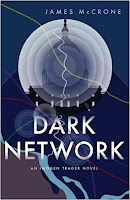“The Silkworm” by Robert Galbraith – The Threat of the Pen
It is said that the pen is mightier than the sword, and I do have to agree with that statement, unless of course we are talking about being on a medieval battlefield (where a pen would only be a useful weapon in McGuyver's hands).
Countless people around the world have been coerced, blackmailed and murdered for words they have put on paper, and it is understandable in a certain sense; after all, it is possible to utterly demolish someone's life with nothing but a few words.
In The Silkworm by Robert Galbraith (pen name used by J.K. Rowling), it is that characteristic of writing which sets the whole affair in motion, as the wife of Owen Quine hires Cormoran Strike, private detective, to find the whereabouts of her missing husband.
Needless to say, the disappearance soon turns out to be a suspicious one, especially considering that Quine has just completed a manuscript, one in which he discusses virtually everyone he knows, painting rather ugly portraits of them with his pen.
In other words, it is the kind of work that can really cast a shadow on certain people's lives and reputations, if not destroy them outright. Not too long after that, Owen Quine is found to be murdered, pitting Cormoran against one of the more malicious and desperation-driven criminals he has encountered in his career.
So what exactly is there to say in this review of the second Cormoran Strike novel by Rowling? Well, to be sure, it is an improvement on the first book, which if you remember was already rather good in itself.
His prose seems to have improved even beyond what it was the first time around, using a more complex language without saturating it abstract descriptions or making the flow feel jagged and uneven. On the contrary, it actually makes for a rather easy read, one where you always know exactly what is happening and where you are.
I think that the characters Galbraith has created this time around are certainly a huge strength of this novel, mainly because he manages to make each and every one of them feel and unique and separate, having their own voices, personalities and backgrounds.
It feels like a real collection of people, ones who are reminiscent of people we actually know, if not ourselves. Very few of them can be definitely classified as good or evil, with most of them falling into that ambiguous grey blur lying in between.
The only thing that feels less-than-excellent (when looked at alongside the book's other traits), is the main mystery itself. It needs the help of other elements to retain the reader's attention, and I have to say that some of the twists and turns feel painfully obvious.
Still, there are still a few surprises hidden here and there, not to mention that there aren't any unwarranted deviations into “experimental” territory; when it comes to the main mystery, Rowling sticks to what is known to work and give solid results.
All in all, The Silkworm is certainly a very nice continuation to the Cormoran Strike novel series, and really showcases J.K. Rowling's ability to diversify her literary works.
I definitely recommend this to anyone looking for a quality thriller that doesn't take risks and simply looks to entertain the reader on a few different fronts.
Countless people around the world have been coerced, blackmailed and murdered for words they have put on paper, and it is understandable in a certain sense; after all, it is possible to utterly demolish someone's life with nothing but a few words.
In The Silkworm by Robert Galbraith (pen name used by J.K. Rowling), it is that characteristic of writing which sets the whole affair in motion, as the wife of Owen Quine hires Cormoran Strike, private detective, to find the whereabouts of her missing husband.
Needless to say, the disappearance soon turns out to be a suspicious one, especially considering that Quine has just completed a manuscript, one in which he discusses virtually everyone he knows, painting rather ugly portraits of them with his pen.
In other words, it is the kind of work that can really cast a shadow on certain people's lives and reputations, if not destroy them outright. Not too long after that, Owen Quine is found to be murdered, pitting Cormoran against one of the more malicious and desperation-driven criminals he has encountered in his career.
So what exactly is there to say in this review of the second Cormoran Strike novel by Rowling? Well, to be sure, it is an improvement on the first book, which if you remember was already rather good in itself.
His prose seems to have improved even beyond what it was the first time around, using a more complex language without saturating it abstract descriptions or making the flow feel jagged and uneven. On the contrary, it actually makes for a rather easy read, one where you always know exactly what is happening and where you are.
I think that the characters Galbraith has created this time around are certainly a huge strength of this novel, mainly because he manages to make each and every one of them feel and unique and separate, having their own voices, personalities and backgrounds.
It feels like a real collection of people, ones who are reminiscent of people we actually know, if not ourselves. Very few of them can be definitely classified as good or evil, with most of them falling into that ambiguous grey blur lying in between.
The only thing that feels less-than-excellent (when looked at alongside the book's other traits), is the main mystery itself. It needs the help of other elements to retain the reader's attention, and I have to say that some of the twists and turns feel painfully obvious.
Still, there are still a few surprises hidden here and there, not to mention that there aren't any unwarranted deviations into “experimental” territory; when it comes to the main mystery, Rowling sticks to what is known to work and give solid results.
All in all, The Silkworm is certainly a very nice continuation to the Cormoran Strike novel series, and really showcases J.K. Rowling's ability to diversify her literary works.
I definitely recommend this to anyone looking for a quality thriller that doesn't take risks and simply looks to entertain the reader on a few different fronts.
 | Robert Galbraith (pen name of J.K. Rowling)Personal site Robert Galbraith is, as it happens, a pen name used by J.K. Rowling as she tried to stray away from children’s stories and go for something more adult-oriented. As of now, the name was only used for the novel The Cuckoo’s Calling. |








Comments
Post a Comment